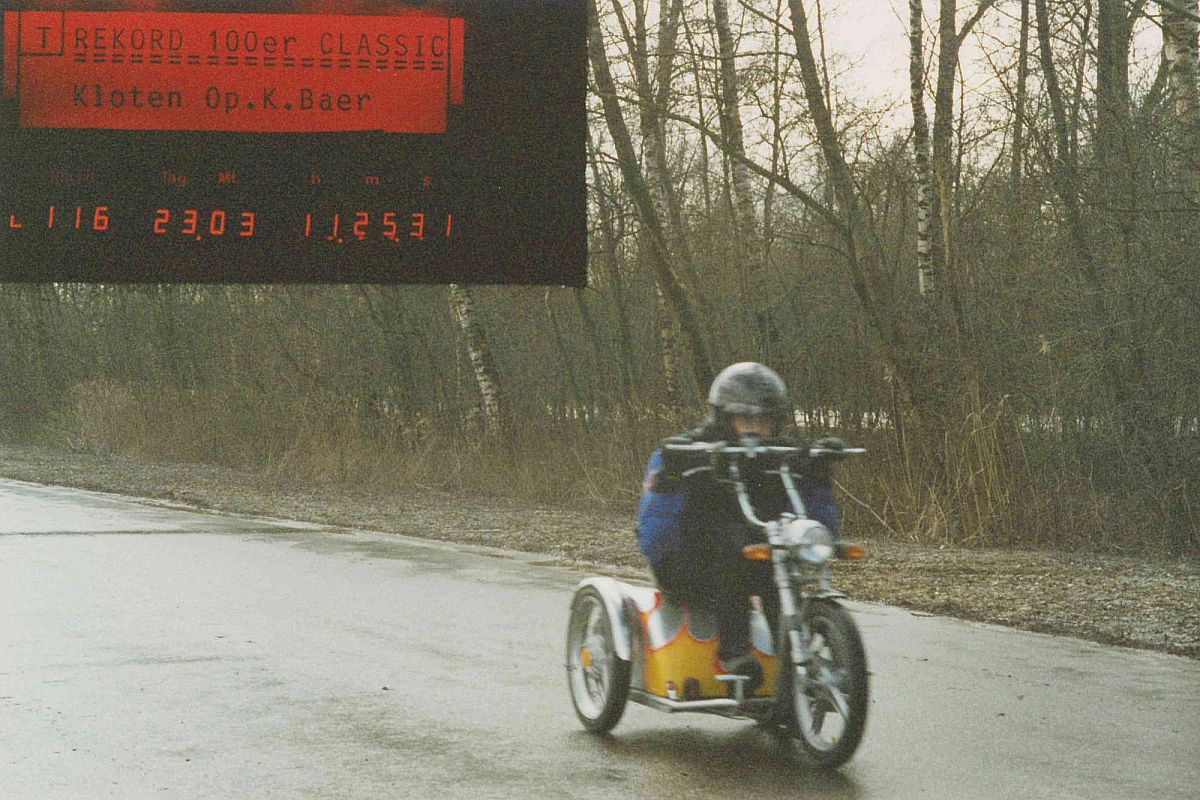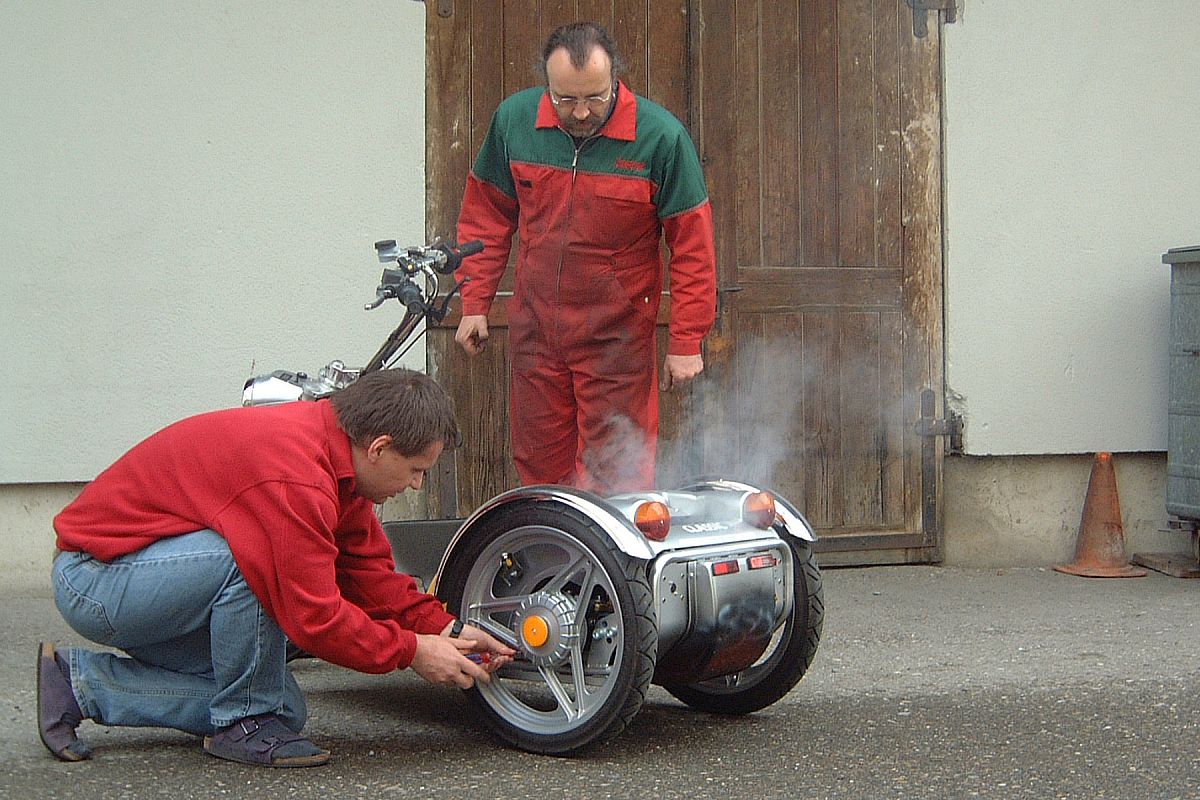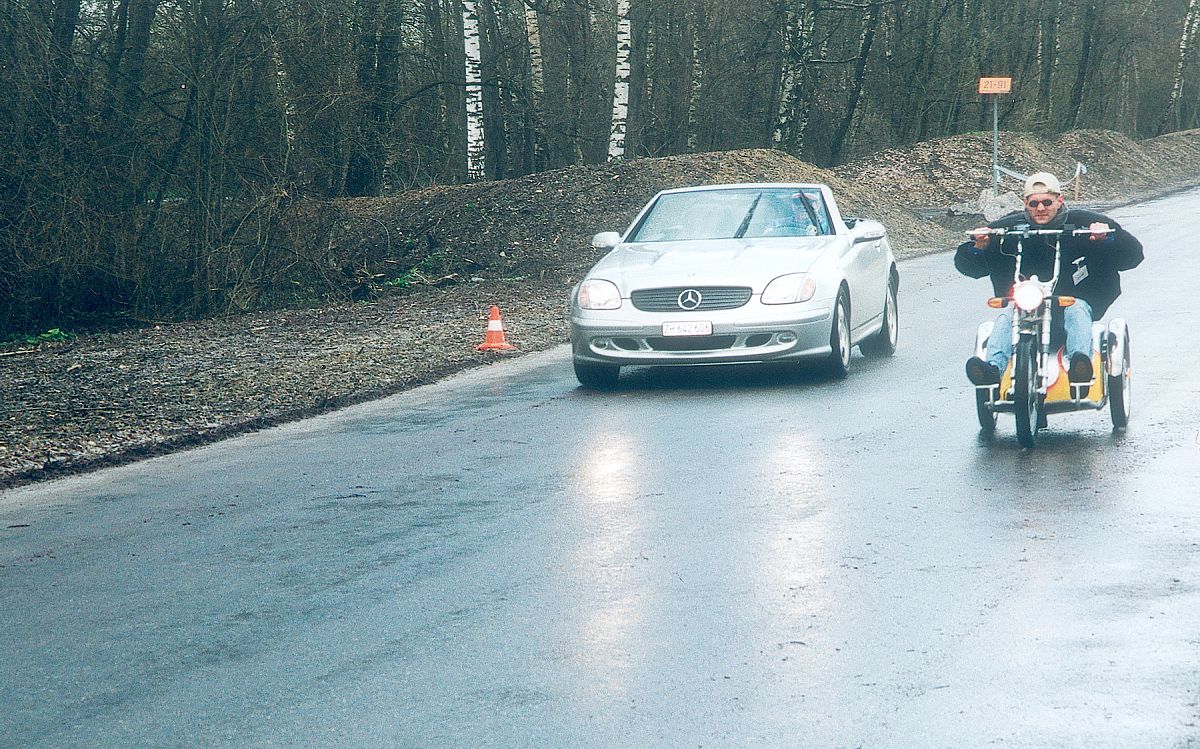The fieriest CLASSIC – CLASSIC 100

Two students from the Ravensburg University of Applied Sciences were with us for their practical semester. One, Armin Rittler, was Stefan's younger brother. The other was Armin's colleague and the son of a metalworker, Jürgen Birnbaum. The two of them worked normally with us and also took on smaller development and construction jobs. Jürgen was a giant. That came in very handy when we were building a gallery. While the two of us of normal size carried a metal girder and transported it to the correct installation height by means of a forklift, Jürgen carried two girders to the construction site and, thanks to his size, stretched them one after the other to the correct position. The welder only had to fix the beams in place. We were making such fast progress with the work that the two trainees urgently needed a task to draw them out. Stefan had the saving idea: "You two take an old CLASSIC 30, the one with the PMG 132 engine, and see what speed you can achieve with it." With full vigour they went to work. What a task! The engine promised a lot. They got in touch with the manufacturer and found out that with a few modifications, the motor could also be operated with a voltage of 132 V. Perfect: from the Cheetah we had very light NiCD battery packs with just this voltage. A drive control was selected that could also deliver up to 200 A at times. This promised an input power of 26 kW - the guarantee for lots of fun. The chassis of the vehicle was lengthened to improve straight-line stability. For safety's sake, the brakes were reinforced, shock absorbers were fitted and the telescopic fork was exchanged for a very high-quality in-house design. An ultra-light carbon seat with a lower seating position to lower the centre of gravity completed the equipment list. Our yard painter Philippe Majeux gave the silvery vehicle a flame pattern to also visually enhance the fast vehicle. One evening, the CLASSIC 100 was ready to drive in front of us. Armin Rittler, Jürgen and I wondered who should now take the first test drive. In the meantime, night had fallen. I sat down on the vehicle, turned the "power handle" and first tested the handling and the brakes. The acceleration was very decent and I reached a maximum speed of
60 km/h. I was very satisfied with the vehicle, the construction and my test drive and rolled back relaxed to report. It was Jürgen's turn. He disappeared and came back with a broad grin: 80 km/h. He was very pleased, I rather less so, as I had trouble seeing the road even at 60 km/h with the only moderate light. It was Armin's turn. He disappeared, it went on for quite a while until he reappeared in the doorway with his hair all tousled and beaming all over. On the speedometer, the maximum speed had climbed to more than 100 km/h. That was enough! I confiscated the key and from then on the CLASSIC 100 was only allowed to be driven on very special occasions. The vehicle was simply too dangerous. Nevertheless, it was great and the task was solved perfectly. What should we do with it? - Be entered in the Guinness Book of Records with the fastest electric wheelchair in the world? The application was filled out. Near Kloten there was the "tank runway". This was an area that belonged to the military and we could reserve it for our record drive. We needed someone else for the measurement and booked Mr Baer for this. Kurt was normally on the road with his VW bus, in which a radar system was permanently installed. He worked on behalf of the Canton of Zurich and was the one who carried out speed measurements. With our action we made sure that at least on that one day no measurements were taken. The day came and we invited all the press, including Tele 24, to duly honour the event. Only the record drive was not enough for us and so we wanted to compare the CLASSIC 100 in an acceleration race against a Mercedes SLK.
The CLASSIC 100 was ready and proved itself in a few test drives. Since the batteries came from "my Cheetah", I wanted to do the charging personally. I programmed a charger to the maximum voltage. The day before the event, I fully charged the vehicle and battery in our office. I briefly went to the workshop to discuss something when the workshop phone rang. My wife at the time, Tina, was on the line: the CLASSIC 100 was smoking, it stank and they had to leave the office now...! I ran back. Obviously the batteries were overcharged. They were smoking heavily and the first flames were already flickering out from under the panelling. I grabbed the vehicle and pushed it out of the office. Seat gone, a mechanic already had the screwdriver in his hands and was unscrewing the boarding. Another grabbed the burning battery with a long hoe, I disconnected the power supply and he ran with the battery to the well trough. There the battery was sunk and cooled down. The vehicle was saved, but the battery was dead. What had happened? In my excitement, I had forgotten a semicolon when programming the charger. After the battery was fully charged and the charging programme was completed, the maximum output voltage was set at the charger - the battery was overcharged. The two students took it easy. They were celebrating that their boss, of all people, had made this mistake. Of course, I was very annoyed.

Fortunately, there was just enough time to clean the whole vehicle again and replace the defective cells in the battery. The other morning, everything was ready for the record drive. Again I was to charge the battery: This time I was overcautious and only gave the vehicle half the possible charge. I was definitely too nervous for a drive. You also have to know where your own limits are. So Lukas sat on the vehicle for the show drive and then Armin Rittler was to take over the record drive. The show drive was about beating the Mercedes SLK in the acceleration race. A first run: the Mercedes was in front. What had happened? Lukas missed the start, apparently the events had not passed him by without leaving a trace. A second attempt. The start worked perfectly, the CLASSIC 100 pulled away and was in front. The Mercedes caught up, but with every shift it fell back a little. That is the advantage of an electric drive: constant torque over the whole speed range, and therefore no shifting is necessary. At about 80 km/h, the winning photo was taken and Lukas had indeed won the acceleration race with the CLASSIC 100. The audience was thrilled. Then came the official record drive. Armin Rittler accelerated and drove first in one direction, then in the other, and Mr Baer determined the speed: 117 km/h was the result. A nice success. We had indeed built the fastest electric wheelchair in the world. In the end, we also got into the Guinness Book of World Records 2002.

At about 80 km/h, the winning photo was taken and Lukas had indeed won the acceleration race with the CLASSIC 100. The audience was thrilled. Then came the official record drive. Armin Rittler accelerated and drove first in one direction, then in the other, and Mr Baer determined the speed: 117 km/h was the result. A nice success. We had indeed built the fastest electric wheelchair in the world. In the end, we also got into the Guinness Book of World Records 2002.
Even though we enjoyed our success. According to the calculation, more should actually be possible, and so I fully charged the batteries a few days later. We wanted to know and got everything out of the vehicle: so we achieved a maximum speed of 141 km/h. What had happened? During the record drive, we had inevitably had to use old batteries. These had not yet been run in optimally. They were also not fully charged, and so the internal resistance affected the maximum acceleration and also the top speed. Correctly adjusted, we reached a top speed of 141 km/h with the CLASSIC 100. Well, we were in the Guinness Book and the two students, and we were completely satisfied. Even a boss has a bad day sometimes, and still it was enough.
I learned from it:
- Even a boss makes mistakes
- With the right team, it can still work
- With the right event, it is possible to prevent mobile speed checks throughout the canton of Zurich for a day
